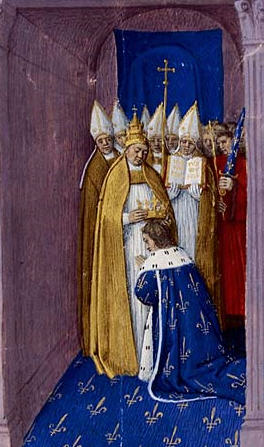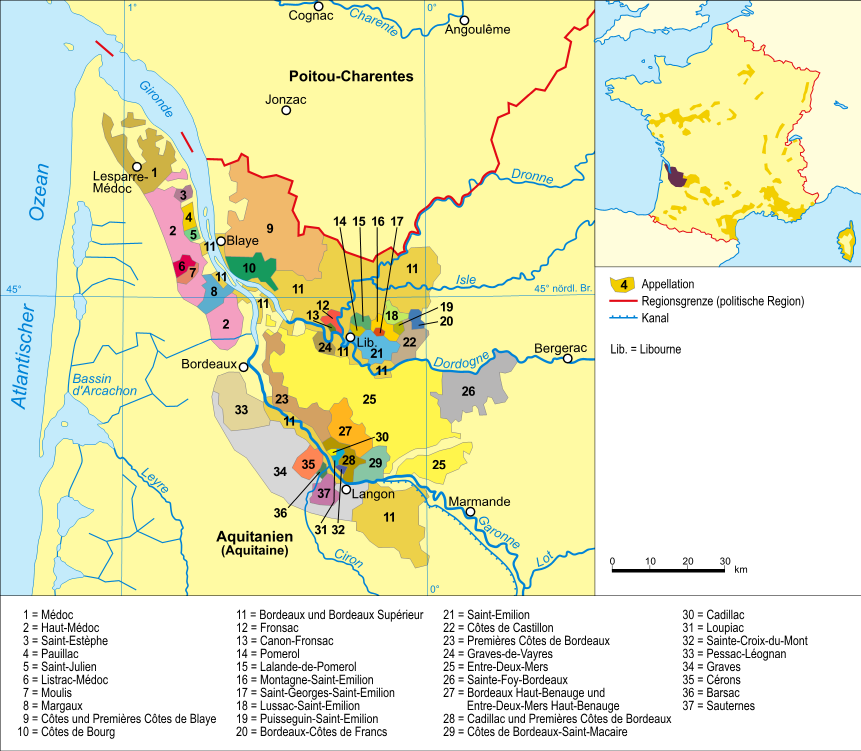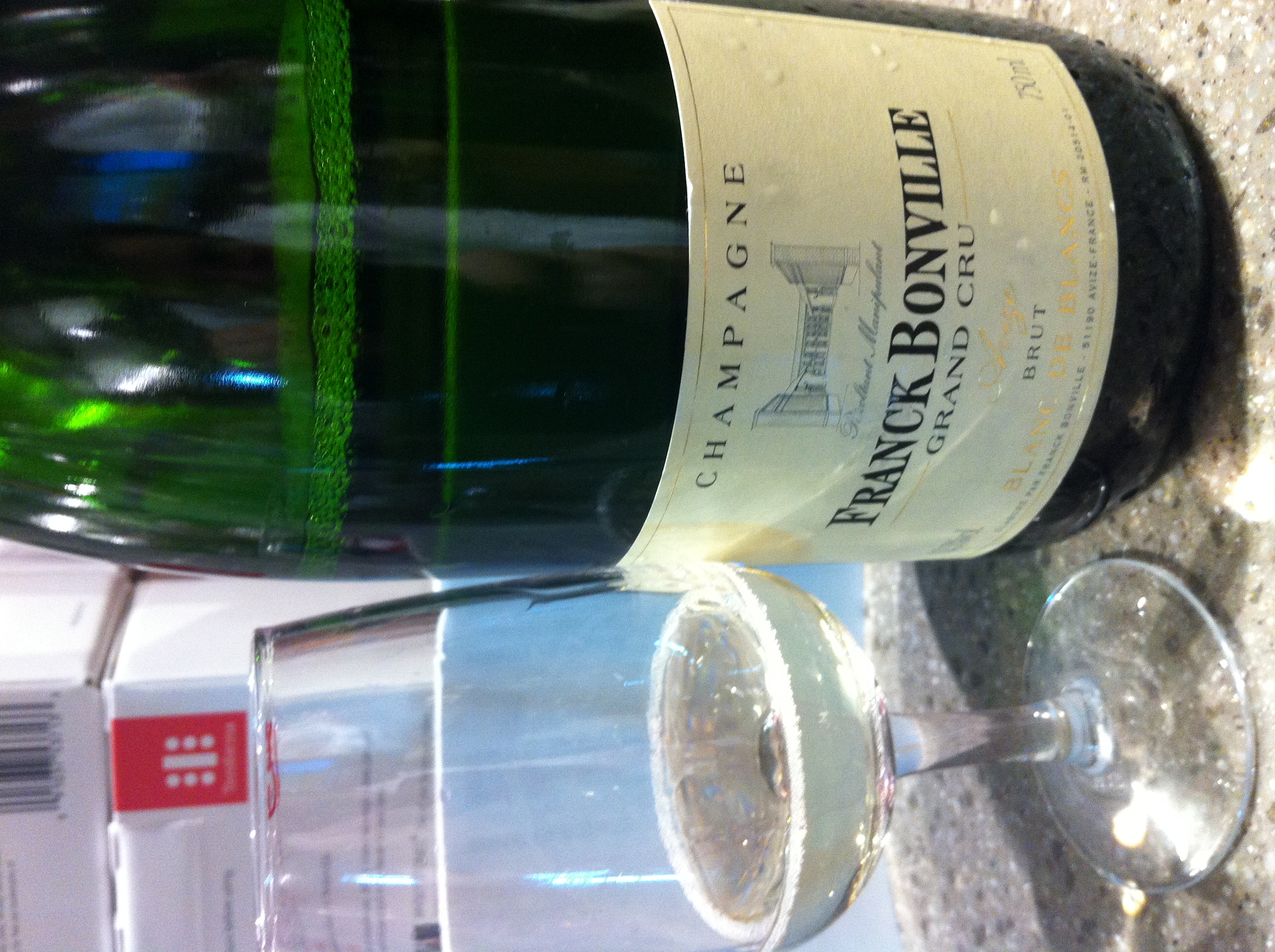|
Fronsac, Gironde
Fronsac (; ) is a commune in the Gironde department in the Nouvelle-Aquitaine region in southwestern France. The town gave its name to the Fronsac AOC wine. Geography The commune is situated in the and is bordered on the south by the river Dordogne and on the east by the river Isle, which separates it from Libourne. Fronsac is 40 km northeast of Bordeaux and 5 km northwest of Libourne and the Saint-Émilion and Pomerol appellations. History Fronsac's mound owes its history to its privileged position. It was the site of the Gauls' market, the Romans erected an altar there, and Charlemagne built a fortified camp on the mound ("Franciacus") in 769, where the Basques led by duke Lupo came to pledge allegiance to the Frankish King after Aquitaine's submission. In 849, Fronsac was pillaged by Hasting, the chief of the Vikings. The Marechal of Richelieu had a "'' folly''" built there, to an extravagant architectural design, where he held courtly entertainments. As ... [...More Info...] [...Related Items...] OR: [Wikipedia] [Google] [Baidu] |
Communes Of France
A () is a level of administrative divisions of France, administrative division in the France, French Republic. French are analogous to civil townships and incorporated municipality, municipalities in Canada and the United States; ' in Germany; ' in Italy; ' in Spain; or civil parishes in the United Kingdom. are based on historical geographic communities or villages and are vested with significant powers to manage the populations and land of the geographic area covered. The are the fourth-level administrative divisions of France. vary widely in size and area, from large sprawling cities with millions of inhabitants like Paris, to small hamlet (place), hamlets with only a handful of inhabitants. typically are based on pre-existing villages and facilitate local governance. All have names, but not all named geographic areas or groups of people residing together are ( or ), the difference residing in the lack of administrative powers. Except for the Municipal arrondissem ... [...More Info...] [...Related Items...] OR: [Wikipedia] [Google] [Baidu] |
Pepin The Short
the Short (; ; ; – 24 September 768), was King of the Franks from 751 until his death in 768. He was the first Carolingian dynasty, Carolingian to become king. Pepin was the son of the Frankish prince Charles Martel and his wife Rotrude of Hesbaye, Rotrude. Pepin's upbringing was distinguished by the ecclesiastical education he had received from the Christian monasticism, Christian monks of the Basilica of Saint-Denis, Abbey Church of St. Denis, near Paris. Succeeding his father as the Mayor of the Palace in 741, Pepin reigned over Francia jointly with his elder brother, Carloman (mayor of the palace), Carloman. Pepin ruled in Neustria, Burgundy, and Provence, while his older brother Carloman established himself in Austrasia, Alemannia, and Thuringia. The brothers were active in suppressing revolts led by the Bavarians, Aquitanians, Saxons, and the Alemanni in the early years of their reign. In 743, they ended the by choosing Childeric III, who was to be the last Merovingian ... [...More Info...] [...Related Items...] OR: [Wikipedia] [Google] [Baidu] |
Guyenne
Guyenne or Guienne ( , ; ) was an old French province which corresponded roughly to the Roman province of '' Aquitania Secunda'' and the Catholic archdiocese of Bordeaux. Name The name "Guyenne" comes from ''Aguyenne'', a popular transformation of ''Aquitania''. In the 12th century it formed, along with Gascony, the duchy of Aquitaine, which passed under the dominion of the kings of England by the marriage of Eleanor of Aquitaine to Henry II. History In the 13th century, as a result of the conquests of Philip II, Louis VIII and Louis IX, Guyenne was confined within the narrower limits fixed by the 1259 Treaty of Paris and became distinct from Aquitaine. Guyenne then comprised the Bordelais (the old countship of Bordeaux), the Bazadais, part of Périgord, Limousin, Quercy and Rouergue, and the Agenais ceded by Philip III to Edward I in the 1279 Treaty of Amiens. Still united with Gascony, it formed a duchy extending from the Charente River to the Pyrenees ... [...More Info...] [...Related Items...] OR: [Wikipedia] [Google] [Baidu] |
Communes Of The Gironde Department
The following is a list of the 534 communes of the Gironde department of France. The communes cooperate in the following intercommunalities (as of 2025):Périmètre des groupements en 2025 BANATIC. Accessed 28 May 2025. * * Communauté d'agglomération du Bassin d'Arcachon Nord * Communauté d'agglomération Bassin d'Arcachon Sud< ... [...More Info...] [...Related Items...] OR: [Wikipedia] [Google] [Baidu] |
Gironde River
The Gironde estuary ( , US usually ; , ; , ) is a navigable estuary (though often referred to as a river) in southwest France and is formed from the meeting of the rivers Dordogne and Garonne just downstream of the centre of Bordeaux. Covering around , it is the largest estuary in western Europe. Giving its name to the French ''département'' Gironde, the Gironde estuary is approximately long and 3–12 km (2–7 miles) wide. It is subject to very strong tidal currents and great care is needed when navigating the estuary by any size or type of boat. Since 2015, the Gironde estuary has been part of the Gironde estuary and Pertuis sea Marine Nature Park. Islands of the Gironde Within the estuary between the Pointe de Grave at the seaward end and the Bec d'Ambès are a series of small islands. The Île de Patiras is in size with a lighthouse to aid navigation in the estuary. Vines and maize are grown there. The Île Sans-Pain and Île Bouchaud are now v ... [...More Info...] [...Related Items...] OR: [Wikipedia] [Google] [Baidu] |
Pasiano Di Pordenone
Pasiano di Pordenone (; ) is a (municipality) in the Province of Pordenone, Regional decentralization entity of Pordenone, in the Italy, Italian region of Friuli-Venezia Giulia, located about northwest of Trieste and about south of Pordenone. Geography Pasiano borders the following municipalities: Azzano Decimo, Gorgo al Monticano, Mansuè, Meduna di Livenza, Porcia, Friuli-Venezia Giulia, Porcia, Pordenone, Prata di Pordenone, Pravisdomini. International relations Twin towns — sister cities Pasiano di Pordenone is Sister city, twinned with: * Canton de Fronsac, France People *Damiano Damiani (1922–2013), Italian screenwriter, film director, actor and writer References External links * Cities and towns in Friuli-Venezia Giulia {{FriuliVeneziaGiulia-geo-stub ... [...More Info...] [...Related Items...] OR: [Wikipedia] [Google] [Baidu] |
Joachim Rouhault De Gamaches
Joachim Rouault (died 1478), a French soldier, was a member of an old family of Poitou. He attached himself to the Dauphin (afterwards Louis XI) and became his premier squire. He followed Louis in his expedition against the Swiss in 1444, distinguished himself in the war against England in 1448, and received the posts of governor of Blaye and Fronsac and constable of Bordeaux. After taking an important part in the Battle of Castillon (1453), which resulted in the defeat and death of John Talbot, 1st Earl of Shrewsbury, he fought against Jean V of Armagnac in 1455. In the following year, he made a fruitless expedition into Scotland. He took part in the campaign in Catalonia, and became Marshal of France in 1461, and governor of Paris in 1471. In 1471 and 1472 he defended Amiens and Beauvais against the Burgundian State The Burgundian StateB. Schnerb, ''L'État bourguignon'', 1999 ( ; ) was a composite monarchy ruled by the Dukes of Burgundy from the late 14th to the late 15 ... [...More Info...] [...Related Items...] OR: [Wikipedia] [Google] [Baidu] |
Monument Historique
() is a designation given to some national heritage sites in France. It may also refer to the state procedure in France by which national heritage protection is extended to a building, a specific part of a building, a collection of buildings, a garden, a bridge, or other structure, because of their importance to France's architectural and historical cultural heritage. Both public and privately owned structures may be listed in this way, as well as movable objects. there were 44,236 monuments listed. The term "classification" is reserved for designation performed by the French Ministry of Culture for a monument of national-level significance. Monuments of lesser significance may be "inscribed" by various regional entities. Buildings may be given the classification (or inscription) for either their exteriors or interiors. A monument's designation could be for a building's décor, its furniture, a single room, or even a staircase. An example is the classification of the déco ... [...More Info...] [...Related Items...] OR: [Wikipedia] [Google] [Baidu] |
The Republicans (France)
The Republicans (, ; LR) is a liberal-conservative List of political parties in France, political party in France, largely inspired by the tradition of Gaullism. The party was formed in 2015 as the refoundation of the Union for a Popular Movement (UMP), which had been established in 2002 under the leadership of the then-president of France, Jacques Chirac. LR is a member of the Centrist Democrat International and the European People's Party, and sits in the European People's Party Group in the European Parliament. The UMP used to be one of the two major party, major political parties in the French Fifth Republic, Fifth Republic, along with the centre-left Socialist Party (France), Socialist Party, before being eclipsed by the National Rally and Renaissance (French political party), Renaissance. The LR candidate in the 2017 French presidential election, 2017 presidential election, former Prime Minister François Fillon, placed third in the first round, with 20.0% of the vote. Fo ... [...More Info...] [...Related Items...] OR: [Wikipedia] [Google] [Baidu] |
Libournais
The wine regions of Bordeaux in France are a large number of wine growing areas, differing widely in size and sometimes overlapping, which lie within the overarching wine region of Bordeaux, centred on the city of Bordeaux and covering the whole area of the Gironde department of Aquitaine. The Bordeaux region is naturally divided by the Gironde Estuary into a Left Bank area which includes the Médoc and Graves and a Right Bank area which includes the Libournais, Bourg and Blaye. The Médoc is itself divided into Haut-Médoc (the upstream or southern portion) and Bas-Médoc (the downstream or northern portion, often referred to simply as "Médoc"). There are various sub-regions within the Haut-Médoc, including St-Estèphe, Pauillac, St.-Julien and Margaux and the less well known areas of AOC Moulis and Listrac. Graves includes the sub-regions of Pessac-Léognan and Sauternes (among others), and Sauternes in turn includes the sub-region of Barsac. The Libournais includ ... [...More Info...] [...Related Items...] OR: [Wikipedia] [Google] [Baidu] |
Cru (wine)
Cru is a wine term used to indicate a high-quality vineyard or group of vineyards. It is a French word which was originally used to refer to both a region and anything grown in it, but is now mostly used to refer to both a vineyard and its wines. The term is often used within classifications of French wine. By implication, a wine that displays (or is allowed to display) the name of its ''cru'' on its wine label is supposed to exhibit the typical characteristics of this vineyard or group of vineyards. The terms ''premier cru'' and ''grand cru'' designate levels of presumed quality that are variously defined in different wine regions. ''Premier cru'' ''Premier cru'' is a French language wine term corresponding to "first growth" and which can be used to refer to classified vineyards, wineries and wines, with different meanings in different wine regions:J. Robinson (ed.). ''The Oxford Companion to Wine'', Third Edition. p. 544. Oxford University Press, 2006. . * For Bordeaux win ... [...More Info...] [...Related Items...] OR: [Wikipedia] [Google] [Baidu] |
Palace Of Versailles
The Palace of Versailles ( ; ) is a former royal residence commissioned by King Louis XIV located in Versailles, Yvelines, Versailles, about west of Paris, in the Yvelines, Yvelines Department of Île-de-France, Île-de-France region in France. The palace is owned by the government of France and since 1995 has been managed, under the direction of the Ministry of Culture (France), French Ministry of Culture, by the Public Establishment of the Palace, Museum and National Estate of Versailles. About 15,000,000 people visit the palace, park, or gardens of Versailles every year, making it one of the most popular tourist attractions in the world. Louis XIII built a hunting lodge at Versailles in 1623. His successor, Louis XIV, expanded the château into a palace that went through several expansions in phases from 1661 to 1715. It was a favourite residence for both kings, and in 1682, Louis XIV moved the seat of his court and government to Versailles, making the palace the ''de fact ... [...More Info...] [...Related Items...] OR: [Wikipedia] [Google] [Baidu] |







